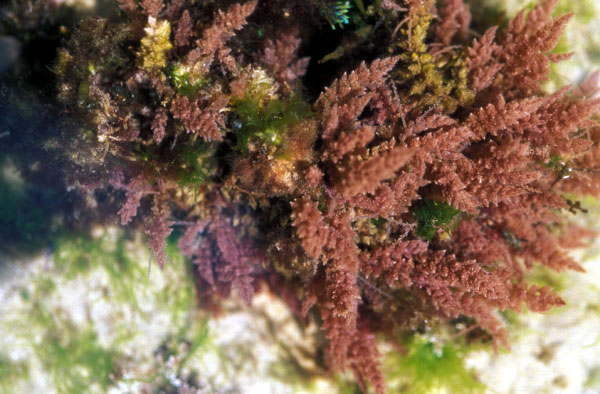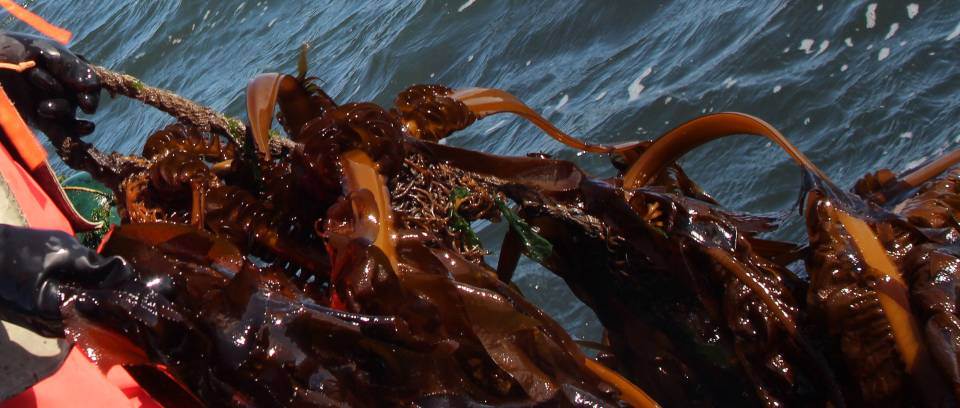Seaweeds have a long history of use as food, as flavouring agents, and find use in traditional folk medicine. Seaweed products range from food, feed, and dietary supplements to pharmaceuticals, and from bioenergy intermediates to materials. At present, 98% of the seaweed required by the seaweed industry is provided by five genera and only ten species. The two brown kelp seaweeds Laminaria digitata, a native Irish species, and Macrocystis pyrifera, a native New Zealand species, are not included in these eleven species, although they have been used as dietary supplements and as animal and fish feed. The properties associated with the polysaccharides and proteins from these two species have resulted in increased interest in them, enabling their use as functional foods. Improvements and optimisations in aquaculture methods and bioproduct extractions are essential to realise the commercial potential of these seaweeds. Recent advances in optimising these processes are outlined in this review, as well as potential future applications of L. digitata and, to a greater extent, M. pyrifera which, to date, has been predominately only wild-harvested. These include bio-refinery processing to produce ingredients for nutricosmetics, functional foods, cosmeceuticals, and bioplastics. Areas that currently limit the commercial potential of these two species are highlighted.
Digital library
-
-
This volume addresses the potential for combining large-scale marine aquaculture of macroalgae, molluscs, crustaceans, and finfish, with offshore structures, primarily those associated with energy production, such as wind turbines and oil-drilling platforms. The volume offers a comprehensive overview and includes chapters on policy, science, engineering, and economic aspects to make this concept a reality. The compilation of chapters authored by internationally recognized researchers across the globe addresses the theoretical and practical aspects of multi-use, and presents case studies of research, development, and demonstration-scale installations in the US and EU.
-
Scientist fear that the largest and most prized species of the hardy 'opihi a uniquely Hawaiian delicacy may be essentially extinct on O'ahu, and the popluation of other limpets statewide is also on the decline. "Pupu" in Hawaiian means "snail" and in modern times it is used to mean hors d'oeuvres. Opihi were the most favored pupu traditionally.
-
Aquaculture has a tradition of about 4 000 years. It began in China, possibly due to the desires of an emperor to have a constant supply of fish. It is speculated that the techniques for keeping fish in ponds originated in China with fishermen who kept their surplus catch alive temporarily in baskets submerged in rivers or small bodies of water created by damming one side of a river bed. Another possibility is that aquaculture developed from ancient practices for trapping fish, with the operations steadily improving from trapping-holding to trapping-holding-growing, and finally into complete husbandry practices (Ling, 1977).
Table 5. Possible environmental Impacts of aquaculture
Culture System
Environmental Impact
EXTENSIVE
1. Seaweed culture
May occupy formerly pristine reefs; rough weather losses; market competition; conflicts/failures, social disruption.
2. Coastal bivalve culture (mussels, oysters, clams, cockles)
Public health risks and consumer resistance (microbial diseases, red tides, industrial pollution; rough weather losses; seed shortages; market competition especially for export produce; failures, social disruption.
3. Coastal fishponds (mullets, milkfish, shrimps, tilapias)
Destruction of ecosystems, especially mangroves; increasingly non-competitive with more intensive systems; nonsustainable with high population growth; conflicts/failures, social disruption.
4. Pen and cage culture in eutrophic waters and/or rich benthos (carps, catfish, milkfish tilapias)
Exclusion of traditional fishermen; navigational hazards; conflicts, social disruption; management difficulties; wood consumption.
SEMI-INTENSIVE
1. Fresh- and brackishwater pond (shrimps and prawns, carps, catfish, milkfish, mullets, tilapias)
Freshwater: health risks to farm workers from waterborne diseases. Brackishwater: salinization/acidification of soils/aquifers. Both: market competition, especially for export produce; feed and fertilizer availability/prices; conflicts/failures, social disruption.
2. Integrated agriculture-aquaculture (rice-fish; live stock/poultry-fish; vegetables - fish and all combinations of these)
As freshwater above, plus possible consumer resistance to excreta-fed produce; competition from other users of inputs such as livestock excreta and cereal brans; toxic substances in livestock feeds (e.g., heavy metals) may accumulate in pond sediments and fish; pesticides may accumulate in fish.
3. Sewage-fish culture (waste treatment ponds; latrine wastes and septage used as pond inputs; fish cages in wastewater channels)
Possible health risks to farm workers, fish processors and consumers; consumer resistance to produce.
4. Cage and pen culture, especially in eutrophic waters or on rich benthos (carps, catfish, milkfish, tilapias)
As extensive cage and pen Systems above.
INTENSIVE
1. Freshwater, brackishwater and marine ponds (shrimps; fish, especially carnivores - catfish, snakeheads, groupers, sea bass, etc.)
Effluents/drainage high in BOD and suspended solids; market competition, especially for export product; conflicts/failures, social disruption.
2. Freshwater, brackishwater and marine cage and pen culture (finfish, especially carnivores -groupers, sea bass, etc. - but also some omnivores such as common carp)
Accumulation of anoxic sediments below cages due to fecal and waste feed build-up; market competition, especially for export produce; conflicts/failures, social disruption; consumption of wood and other materials.
3. Other - raceways, silos, tanks, etc.
Effluents/drainage high in BOD and suspended solids; many location-specific problems.
Source: Modified from Pullin, 1989
Chinese who emigrated to other Southeast Asian countries probably carried the knowledge with them and inspired the local people to take up fish farming. Brackishwater aquaculture is thought to have originated in Indonesia with the culture of milkfish and grey mullet (Ling, 1977) and must have spread to neighbouring countries like the Philippines which has been practising it for about 300 to 400 years (Baluyut, 1989).
The husbandry of fish is therefore not a new phenomenon. Ancient practices based on the modifications of natural bodies of water or wetlands to entrap young fish in enclosures until harvest, have just evolved into more systematic and scientific methods and techniques.
Other regions of the world have shorter traditions of aquaculture. In North America, it is about a century old; in Africa, aquaculture production consists almost exclusively of tilapia culture in freshwater ponds and dates back to the 1940s (UNDP/NORAD/FAO, 1987). Aquaculture development has been very recent and is just gaining momentum in Australia, New Zealand, and the Pacific Island countries (Rabanal, 1988b).
-
Aquaculture, especially in the Western World, is very often conducted in a monotypic manner without employing a balanced approach for long-term sustainability, which would take into consideration the assimilative capacity of the ecosystem. To develop innovative, effective and responsible practices ñ maintaining the health of coastal waters, and, consequently, of the cultured organisms ñ fed aquaculture types (e.g. finfish, shrimp) and organic or inorganic extractive aquaculture types (e.g. shellfish or seaweed) need to be integrated to avoid pronounced shifts in coastal processes. Most impact studies on aquaculture operations typically have focused on organic matter/sludge deposition. However, the inorganic output of aquaculture is presently emerging as a pressing issue as nutrification of coastal waters is a worldwide phenomenon, which has not spared the Bay of Fundy (Chopin et al. in press). Conversion, not dilution, is the solution so that the ìwastesî of one resource user become a resource (fertilizers) for the others. It can frequently be heard that the development of ìalternativeî species will reduce some of the aquaculture impacts. Unfortunately, too often ìalternative speciesî in the minds of a lot of people means ìalternative speciesÖ of fishî. Even though introducing another species of fish may add up economically in the short term, rarely does it balance energetically and environmentally in the long term. It is still fed aquaculture, with extra, unconsumed, pellets and unidirectional metabolic excretion. For a balanced ecosystem approach what is needed is a diversity of co-cultured organisms, performing different processes throughout the day and seasonally, and an estimate of the proportionate biomass of each so that their metabolic processes compensate each other.
-
In the past two decades, there has been much debate amongst industry, the state development agencies and the research institutions about the potential of the Irish seaweed sector. Seaweed gathering and processing is a traditional activity in Ireland bringing economic activity and employment to coastal communities. Ireland’s seaweed and biotechnology sector is currently worth €18 million per annum and employs 185 full time equivalent people (Morrissey et al., 2011). The potential to increase employment, exports and wealth from seaweed in Ireland was looked at by the National Seaweed Forum which was established in 1999 to join industry with research bodies, state agencies and departments to make recommendations for the future development of the industry.
One such recommendation was the development of seaweed cultivation. With this in mind, groups such as Bord Iascaigh Mhara (BIM), Taighde Mara Teo (TMT), National University Ireland Galway (NUIG) and Queen’s University Belfast (QUB) initiated seaweed cultivation trials. These early trials had varied success and allowed for experimentation and year-on-year technique improvement. Farming seaweed as opposed to simply gathering seaweed requires a thorough knowledge of seaweeds and perfect manipulation of the seaweed life cycle. Mastering this has concerned Irish seaweed researchers and industry practitioners alike over the last decade.
The Seaweed Hatchery project has focused on developing new techniques, and improving existing knowledge of seaweed cultivation. This manual is one such output of the project. The manual is offered to the industry as a guide to the hatchery techniques required to develop new aquaculture opportunities for Laminaria digitata.
As with all BIM ‘Aquaculture Explained’ manuals, it is based on the research and experiences of the group and includes both hatchery and sea trial cultivation results obtained over several years and sites. An attempt has been made to provide an easy to use document filled with practical advice for those interested in growing kelp.
-
In this paper, the different possibilities and innovations related to sustainable aquaculturein the Mediterranean area are discussed, while different maricultural methods, and the role ofIntegrated Multi-Trophic Aquaculture (IMTA) in supporting the exploitation of the ocean’s resources,are also reviewed. IMTA, and mariculture in general, when carefully planned, can be suitablefor environmental restoration and conservation purposes. Aquaculture, especially mariculture, isa sector that is progressively increasing in parallel with the increase in human needs; however,several problems still affect its development, mainly in relation to the choice of suitable sites, fodderproduction, and the impact on the surrounding environment. A current challenge that requiressuitable solutions is the implementation of IMTA. Unfortunately, some criticisms still affect thisapproach, mostly concerning the commercialization of new products such as invertebrates andseaweeds, notwithstanding their environmentally friendly character. Regarding the location of asuitable site, mariculture plans are currently displaced from inshore to offshore, with the aim ofreducing the competition for space with other human activities carried out within coastal waters.Moreover, in open water, waste loading does not appear to be a problem, but high-energy watersincrease maintenance costs. Some suggestions are given for developing sustainable mariculture inthe Mediterranean area, where IMTA is in its infancy and where the scarce nutrients that characterizeoffshore waters are not suitable for the farming of both filter feeder invertebrates and macroalgae.From the perspective of coupling mariculture activity with restoration ecology, the practices suggestedin this review concern the implementation of inshore IMTA, creating artificially controlled gardens, aswell as offshore mussel farming coupled with artificial reefs, while also hypothesizing the possibilityof the use of artificially eutrophized areas.
-
With continued human pressure on marine fisheries and ocean re- sources, aquaculture has become one of the most promising avenues for increasing marine fish production in the future. This review presents recent trends and future prospects for the aquaculture industry, with particular attention paid to ocean farming and carnivorous finfish species. The benefits of farming carnivorous fish have been challenged; extensive research on salmon has shown that farming such fish can have negative ecological, social, and health impacts on areas and parties vastly separated in space. Similar research is only beginning for the new carnivorous species farmed or ranched in marine environments, such as cod, halibut, and bluefin tuna. These fish have large market potential and are likely to play a defining role in the future direction of the aquaculture industry. We review the available literature on aquaculture development of carnivorous finfish species and assess its potential to relieve human pressure on marine fisheries, many of which have experienced sharp declines.
-
Discussion of Tyler Cowen's book, ‘The Great Stagnation’.
-
A component of the recent Australian Centre for International and Agricultural Research-funded sandfish project in the Philippines, Vietnam and Australia has been to build and refine economic decision tools for both sea ranching and pond-based culture of sandfish. Presented here is the background to these models and some basic theory required to understand model outputs. Models take a discounted cash flow approach to predicting returns over a given life cycle. Output includes the expected annual returns when the farm is paid off, and the maximum interest rate at which funds can be borrowed to invest in the project. A risk module allows the user to incorporate anticipated risk to return from a range of sources. Access to these models is open, and a web address is provided.





